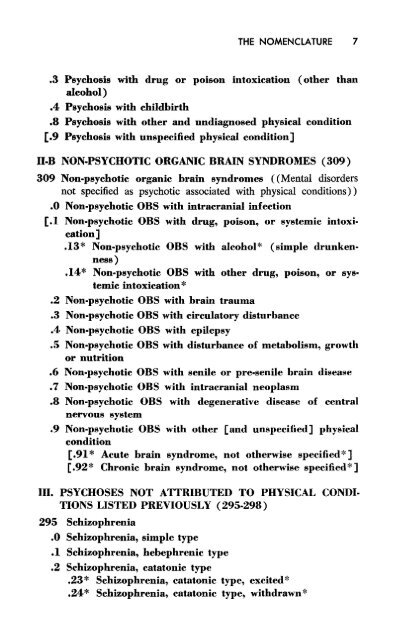DSM+II+1968
DSM+II+1968 DSM+II+1968
MENTAL DISORDERS The United States, however, was not the only country which found the section on mental disorders in ICD-6 unsatisfactory. In 1959, Professor E. Stengel, under the auspices of the World Health Organization, published a study revealing general dissatisfaction in all WHO member countries. 1 This finding, combined with the growing recognition of mental disorders as a major international health concern, led WHO to urge its member states to collaborate in developing a classification of these disorders that would overcome the ICD's shortcomings and gain general international acceptance. Such a classification was recognized as indispensable for international communication and data collection. To initiate the work of revising the ICD, the U. S. Public Health Service then established a series of subcommittees of its National Committee on Vital and Health Statistics, including a Subcommittee on Classification of Mental Disorders. The National Committee is advisory to the Surgeon General on technical matters and developments in the field of vital and health statistics. The goal of all subcommittees was to complete their recommendations in time for consideration by the International Revision Conference, which WHO had scheduled for July 1965. The Subcommittee on Classification of Mental Disorders, appointed by the National Committee on Vital and Health Statistics, comprised Dr. Benjamin Pasamanick, Chairman, Dr. Moses M. Frohlich (then chairman of the APA Committee on Nomenclature and Statistics), Dr. Joseph Zubin, and the author. Later, Dr. Henry Brill was made Chairman of the APA Committee and replaced Dr. Frohlich on the Subcommittee. Dr. Leon Eisenberg, a child psychiatrist, was also added to the Subcommittee. Throughout, the Subcommittee worked very closely with Dr. Brill in the latter's capacity as chairman of the APA Committee, and he actively participated in developing the Draft Classification that was submitted by the U. S. to the first meeting of the Subcommittee on Classification of Diseases of the WHO Expert Committee on Health Statistics in Geneva, Switzerland in November 1961. Dr. Brill was present at the meeting as an adviser. Following this meeting, the possibility and desirability occurred to the U. S. Subcommittee of working with colleagues in the United Kingdom to develop and agree upon a single classification of mental 1 Stengel, E. (1960), "Classification of Mental Diseases", Bull, of Wld. Hlth. Org., 21, 601 Xll
- Page 2: DSM-II DIAGNOSTIC AND STATISTICAL M
- Page 6: Committee on Nomenclature and Stati
- Page 10: TABLE OF CONTENTS Foreword by Ernes
- Page 14: FOREWORD Ernest M. Gruenberg, M.D.,
- Page 18: FOREWORD of many views. It did not
- Page 22: INTRODUCTION: THE HISTORICAL BACKGR
- Page 28: MENTAL DISORDERS with organic or ph
- Page 32: This page intentionally left blank
- Page 36: 2 MENTAL DISORDERS ganic brain synd
- Page 40: 4 MENTAL DISORDERS patient's degree
- Page 44: 6 MENTAL DISORDERS II-A. PSYCHOSES
- Page 48: 8 MENTAL DISORDERS .3 Schizophrenia
- Page 52: 10 MENTAL DISORDERS .89* Other pers
- Page 56: 12 MENTAL DISORDERS .0* Adjustment
- Page 60: Section3 THE DEFINITIONS OF TERMS I
- Page 64: 16 MENTAL DISORDERS Bilirubin encep
- Page 68: 18 MENTAL DISORDERS Glucogenosis (V
- Page 72: 20 MENTAL DISORDERS Hydrocephalus,
MENTAL DISORDERS<br />
The United States, however, was not the only country which found<br />
the section on mental disorders in ICD-6 unsatisfactory. In 1959, Professor<br />
E. Stengel, under the auspices of the World Health Organization,<br />
published a study revealing general dissatisfaction in all WHO member<br />
countries. 1 This finding, combined with the growing recognition of<br />
mental disorders as a major international health concern, led WHO to<br />
urge its member states to collaborate in developing a classification of<br />
these disorders that would overcome the ICD's shortcomings and gain<br />
general international acceptance. Such a classification was recognized<br />
as indispensable for international communication and data collection.<br />
To initiate the work of revising the ICD, the U. S. Public Health<br />
Service then established a series of subcommittees of its National<br />
Committee on Vital and Health Statistics, including a Subcommittee on<br />
Classification of Mental Disorders. The National Committee is advisory<br />
to the Surgeon General on technical matters and developments in the<br />
field of vital and health statistics. The goal of all subcommittees was<br />
to complete their recommendations in time for consideration by the<br />
International Revision Conference, which WHO had scheduled for<br />
July 1965.<br />
The Subcommittee on Classification of Mental Disorders, appointed<br />
by the National Committee on Vital and Health Statistics, comprised<br />
Dr. Benjamin Pasamanick, Chairman, Dr. Moses M. Frohlich (then<br />
chairman of the APA Committee on Nomenclature and Statistics),<br />
Dr. Joseph Zubin, and the author. Later, Dr. Henry Brill was made<br />
Chairman of the APA Committee and replaced Dr. Frohlich on the<br />
Subcommittee. Dr. Leon Eisenberg, a child psychiatrist, was also<br />
added to the Subcommittee.<br />
Throughout, the Subcommittee worked very closely with Dr. Brill in<br />
the latter's capacity as chairman of the APA Committee, and he actively<br />
participated in developing the Draft Classification that was submitted<br />
by the U. S. to the first meeting of the Subcommittee on Classification<br />
of Diseases of the WHO Expert Committee on Health Statistics in<br />
Geneva, Switzerland in November 1961. Dr. Brill was present at the<br />
meeting as an adviser.<br />
Following this meeting, the possibility and desirability occurred to<br />
the U. S. Subcommittee of working with colleagues in the United<br />
Kingdom to develop and agree upon a single classification of mental<br />
1 Stengel, E. (1960), "Classification of Mental Diseases", Bull, of Wld. Hlth.<br />
Org., 21, 601<br />
Xll



